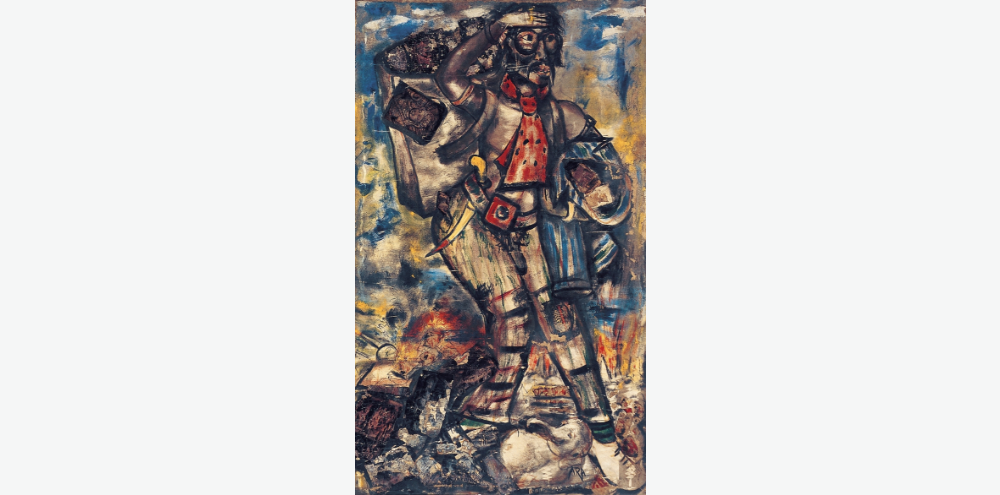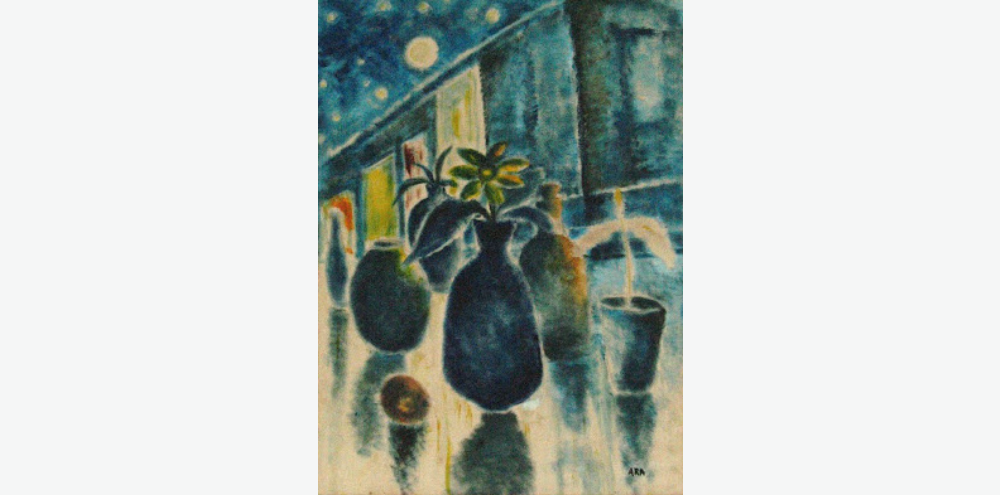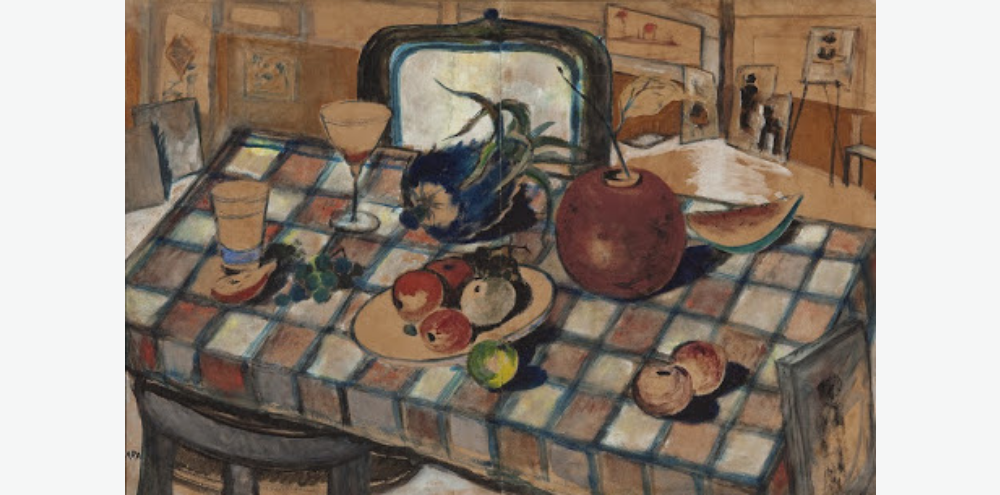Progressive Artists Group: Figuration as Dominant Approach to Indian Art After Independence
Progressive Artists Group and related circles
The Progressive Artists Group has been well known and studied. Initially, the Group was composed of six artists, FN Souza, SH Raza, MF Husain, KH Ara, HA Gade, and SK Bakre, who came from disparate religious and cultural backgrounds across India, later becoming an umbrella term for many artists working in the same orbit. Work by PAG artists was marked by a degree of optimism befitting a new nation and artistic experimentation, as they purposely did not come together around a specific style or set of formal aesthetics.
Together they presented a manifesto, marking a similarity to artists’ groups in Europe, some of which banded around radical politics and others around aesthetics. F.N. Souza, who could be seen as the Progressive Artists Group’s spokesman, stated the Group’s aims as follows:
“Today we paint with absolute freedom for content and techniques almost anarchic; save that we are governed by one or two sound elemental and eternal laws, of aesthetic order, plastic coordination, and color composition. We have no pretensions of making vapid revivals of any school or movement in art. We have studied the various schools of painting and sculpture to arrive at a vigorous synthesis.”
This statement was intended as a repudiation of academic art schools and the Bombay Art Society, both of which were cloaked in a British colonial legacy. The PAG aimed to fashion new aesthetics and new roles for artists in India. The fashioning of the artist as professional was central to their project.
Figuration in the works of PAG
Let’s look at a few key examples of works by PAG artists that give a window into the concerns and directions that figuration took in these years.
F.N Souza: Artist as professional
Born to Catholic parents in Goa in 1924, Souza is known for his controversial nudes, portraying women and Christ with an approach to line and form that often appears aggressive or even violent.
In Self Portrait, 1949, Souza turns his gaze toward himself, adopting a Picasso-esque pose, through which he seems to declare himself to be a revolutionary modern, literally stripped of conventional constraints, including clothing. More than just a figure or a self-portrait or a body, this work shows how Souza prioritises his professional identity as an artist, with his brush in front of his body (in spite of the oddness of appearing to paint while nude).
M.F Husain: Reckoning with the new nation
Of the artists affiliated with the PAG, MF Husain has gone onto the greatest celebrity as a symbol of modern India and – as discussed in Lesson 1 – a political target.
His important work Man, 1951 is hopeful in its modernism and bold in its deconstruction of the human figure, presenting a heroic philosophical figure surrounded by chaos. In this work, Husain includes masked dancing folk figures, naked female bodies, and the image of the sacred cow. The central figure, who appears to hold a painting of two nude women, sits crouched in contemplation and may be an avatar for Husain himself. While the figures around him suggest a swirl of activity, rectangular borders hint at canvases in an artist’s studio, posing somewhat of a parallel to Souza’s self-representation as an artist. Surrounded by the chaos of the new India or the controlled chaos of the studio, Husain’s thinker gazes outward.
The artist began his life as a painter working on Bollywood billboards in Bombay, and certain qualities of this commercial work remain visible in Man and, in fact, across his oeuvre. In this painting, we see boldly outlined figures and a work built up through a decisive overlay of solid colors. The painting also references the proportions of a billboard, albeit at a reduced scale. Throughout his career, India – urban and rural, modern and traditional, sacred and secular — remained the central subject of Husain’s work; this was also true of other PAG artists whose approaches were quite different.
KH Ara: modern depictions of folk traditions
Let’s contrast a 1945 work by KH Ara, an artist born in Secundarabad in 1914 who ran away at the age of seven to Mumbai, the city that would remain his home for the rest of his life. In Bharata Natya, 1945, Ara depicts a Bharat Natyam classical Indian dance performance featuring the renowned Indian dancer and choreographer Ram Gopal amidst a large crowd in a temple setting in South India. The form originated in Tamil Nadu, and this temple hall (mandapa) appears to be a large Chola period temple, representing a peak of South Indian architecture. This work integrates a modern expressive approach with a traditional setting, and is typical of Ara’s focus on composed human situations. The performance is depicted from the audience’s perspective and great care is taken to show the group of largely women in view. Ara’s energetic brushwork and use of bright lively colors convey anticipation and movement, befitting the subject.
The artists of the PAG left behind an indelible mark on the trajectory of Indian modernism. Although disparate in their stylistic language and visual aesthetics, their works shared a similar preoccupation with new forms of experimentation, a distancing from the colonial schools of art, and simultaneously a renewed sense of optimism amidst the newly independent nation-state. The PAG continued to influence younger generations of artists, not only those immediately following as we will see in the next video, but also those in the decades to come.
Legacy and Beginnings of a Cosmopolitan Art World in Bombay
The core of the Progressive Artists’ Group held its first and only major exhibition in 1949 in Baroda and Bombay. By 1950, some of the original energy of the group began to dissipate, and all of the artists except for Husain went abroad for further training or because they were having a hard time earning enough money in India. The original group disbanded in 1954, though there is a lingering label of the “Progressives” attached to these artists and their younger colleagues.
Artists who became affiliated with the PAG from 1949 onwards include many of India’s most important figures. For instance, Krishen Khanna, born in what is now Faisalabad, Pakistan, trained as a banker in London before moving with his family to India as a result of Partition. His early works reflect the tumult of the time and its impact on his life, as well as a lifelong engagement with the figure. News of Gandhiji’s Death, painted in 1948, is a sorrowful depiction of Indians from various backgrounds gathered under a lamppost reading newspapers carrying word of the assassination of Mahatma Gandhi at the hands of a Hindu nationalist. Reflecting the sectarian tensions Khanna feared, no one is reading together or discussing, but each, with his or her own paper, is reflecting. News of Gandhiji’s Death reflects the PAG’s contradictory misgivings about the Indian national project, as the tragic, catalytic assassination occurred within the first year of Independence.
In the early 1950s, civic sites and informal spaces to see art and promoting the sociality of the art world began to take on importance. The Jehangir Art Gallery was founded in 1952 in the Kala Ghoda area of Bombay, becoming central to the city’s development as an artistic center and remaining central for many artists and publics until the present. At the same time, artists and others would regularly see new artworks at places like Kekoo Gandhy’s frame shop, Chemould, which regularly displayed works, and in turn led to the city’s first permanent commercial art galleries in the 1960s (with Chemould on the second floor of the Jehangir Gallery beginning in 1963, and Pundole Gallery opening in the same area that year too). It’s important to note that there was not a viable art market to speak of through this time, but the presence of a commercial gallery was important as a venue and a step towards a layered, professional art world.
Conclusion
The emergence of the PAG in Bombay, following the crucial moment of independence, also coincided with the kindling of public art spaces in the city. The establishment of several commercial galleries paved the way for a vibrant art world and a community of art collectors and audiences. Today, these galleries continue to be a strong presence in an ever-growing art market, not only within Mumbai, but across the country.








